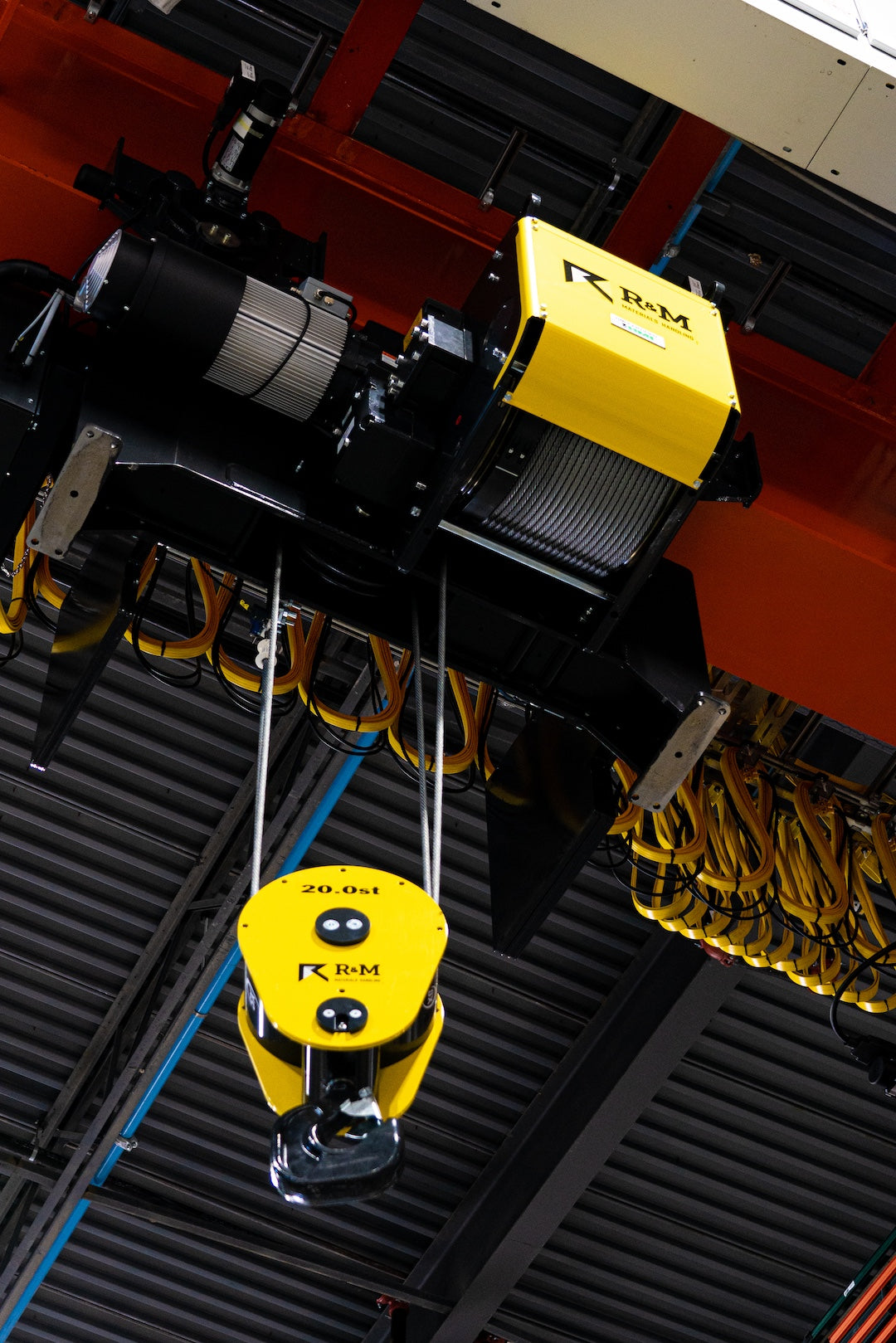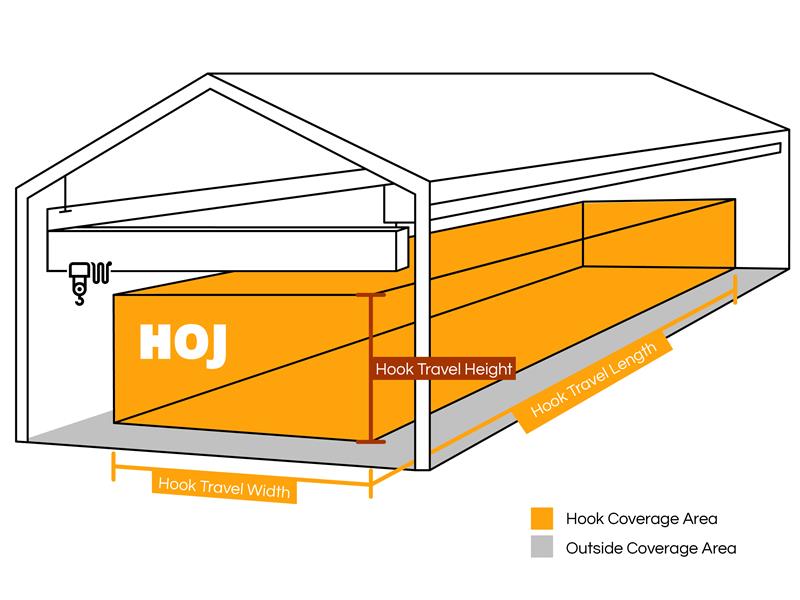Your Cart is Empty

Conveyor & Automation - The Warehouse Floor Ep. 3
In this episode of the podcast, we sit down with Stan Witt, the Director of Automation and Conveyor Systems at Hoj Innovations. With over 28 years of experience, Stan has played a pivotal role in shaping Hoj's automation department into a leader in the industry.
Stan's career journey is nothing short of remarkable. He's been at the forefront of automation technology, from working at Boeing on robotic systems to honing his expertise at a major Japanese material handling company.
Stan reflects on his career:
"I graduated with an engineering degree specializing in design technology and computing. After starting at Boeing and working on automation with robotic systems and tooling, I moved to a Japanese material handling company. That's where I really cut my teeth on automation and material handling before joining Hoj. It's been an exciting ride, especially with the changes in the market."
Joining him on the podcast is Tim Hoj, CEO of Hoj Innovations. Hoj Innovations is a family business with a rich history of success in the material handling industry. For six decades, it has worked with top brands such as Coca-Cola, Phizer, Zyia Active, Cotopaxi, and many more.
Tim HOJ has been CEO for the last 30 years, overseeing everything from pallet racking systems, warehouse design plans, conveyor & robotic automation, bridge cranes, and forklifts.
Together, Stan Witt & Tim Hoj dive into the challenges companies face when integrating automation and share insights from their experiences, including how they've helped clients overcome obstacles to achieve seamless automation solutions.
Table Of Contents
- Key Partner In Automation - Hytrol
- Hytrol Is Quick To Innovate
- Conveyor Is Not Too Expensive For Small Businesses
- Planning For Future Growth Saves Thousands
- New Systems Allowed Me To Enjoy the Holidays
- Overcoming Common Conveyor Hurdles For Companies
- Optimizing For Last Mile Delivery
- The Changes In Packaging
- Automation for High-End Product Sortation
- Small Sortation Robots
- IS AUTOMATION ONLY FOR THE FORTUNE 500 COMPANIES?
- Increasing Throughput & Warehouse Visibility
- Improve Work Environments & Transparency For Floor Workers
- Material Handling Packaged Goods / Robotic Palletizers
- More To Come
Key Partner In Automation - Hytrol

Hytrol has been a critical partner for Hoj Innovations, providing support in complex conveyor and automation projects. Whenever customers need automation or conveyance solutions, Hytrol is always part of the conversation.
As Hytrol states, "We are a world leader in the design and manufacturing of material handling systems. Since 1947, we've dedicated ourselves to pushing forward the industry we're a part of."
Stan quickly stated that One of the standout features that Hytrol brings to the table is their ability to "respond with, design innovations and solutions. It's really refreshing." - Stan.
Reflecting on this long-standing relationship, Tim Hoj texted his Hytrol account rep, asking how long the two companies had been in partnership. The rep replied, "January 6, 1966." For over 58 years, Hytrol has been a trusted partner for Hoj Innovations.
Conveyor Is Not Too Expensive For Small Businesses

One of the features that makes Hytrol such a reliable partner is that all of its conveyor sections are pre-engineered. This not only simplifies the process but also makes Hytrol easy to work with.
As Tim Hoj explains, "The modular nature allows us to [make] designs quickly," which enables Hoj Innovations to provide fast solutions and meet customer deadlines more effectively.
But Hytrol's modularity offers more than just quick design—it also makes conveyor systems more affordable for small businesses. Stan Witt, the head of Automation and Conveyor at Hoj, breaks it down:
"Yes, historically, most of our customers [are] usually in the early stages of their business … and they're still working out of a garage. They're looking to expand, but they're not exactly sure where to spend the money. [Money is] really tight early on in a business, so they want to spend it wisely. And that's really a fun place to be with a customer starting out. We can provide them some conveyor solutions that can grow with them … we're repurposing the conveyor that they've already bought, and that conveyor lasts for years and years and years."
Stan emphasizes that it's rare for a customer to expand without reusing a significant portion—if not all—of their existing conveyor system. "The great thing about Hytrol is [their] conveyor is such great quality that it just lasts for years and years. I mean, there's conveyor out there that's still operating [today] that was put in before I came to work here at Hoj." And that was over 28 years ago.
This long-lasting quality makes it possible for small businesses to start with a basic conveyor system and expand it as their needs grow. Over time, this ability to repurpose existing systems can save businesses hundreds of thousands, if not millions, of dollars as they scale up.
Planning For Future Growth Saves Thousands

At Hoj Innovations, our primary goal is to provide maximum value to our customers, regardless of budget constraints. This approach is especially clear in our conveyor and automation designs.
As Stan explains, when designing solutions, "We're not only looking at what your current needs are but what your needs are going to be in two years, five years. What are your future plans?
Then, we set benchmarks so both we and our customers know that once we reach a certain level of activity or capacity, we know the next step. We've already put together conceptual layouts, so everyone understands
This proactive planning ensures that you're never left guessing when it's time to expand. By setting clear benchmarks, you'll know exactly when it's time to take your operations to the next pre-planned phase.
Stan provides an example from an e-commerce company:
"Companies that enter the market as e-commerce brands have exponential growth curves. It's far greater than what we see in traditional distribution, which is a lot slower and more predictable.
I've walked into situations where customers have grown so much that, while it's great news, it also puts them in a panic mode. They say, 'Next year during Christmas, we need to ship 20,000 packages a day, and we have three weeks to do it. That's when our business goes from operating in the red to the black, so those three weeks are absolutely critical.'
That's one of my favorite parts of being in this business—helping people through those moments."
Growth is a double-edged sword. On the one hand, it's great for a company—more sales mean more profit. On the other hand, how do businesses keep up with increasing demand? Is the solution to work holidays and weekends? The answer is no. With the right planning and automation, you won't need to sacrifice your personal time to keep up with the demand.
New Systems Allowed Me To Enjoy the Holidays Again
Tim Hoj shares a memorable experience from one of his past clients who faced the usual year-end stress:
"When an operator reflects on the year as a success compared to the last, you know you've made a real impact. Last year, they weren't sleeping well, and they couldn't enjoy Thanksgiving dinner when it came around. But with this new system that had enhanced capabilities, everything got out the door. The Q4 rush was managed really well. We didn't have the heartache or stress.
That's when you know you've worked well with a client to truly solve a problem."
This story illustrates the positive side of automation—reduced stress and a smoother operation. However, implementing new systems can require significant upfront costs and training, which some businesses might find challenging in the beginning.
But once the system is in place, the long-term benefits, like stress-free holidays and better operational flow, often outweigh the initial hurdles.
Overcoming Common Conveyor Hurdles For Companies
Tim and Stan then moved on to discuss common issues companies might face when deciding to install conveyors in their warehouses. Below is a summary of the key points they covered:
- Blocking Access Paths: Once a conveyor is installed, it can block paths that were originally open. One common solution is to pre-plan designated walking paths so that workers can move around, under, or over the conveyor with ease.
- High-Traffic Aisles Without Space for Conveyor: For aisles where you can't install conveyors but still need to improve product flow, multi-level pick modules are a great solution. These modules spread picking operations vertically across multiple levels, with conveyors running between floors via ceiling-mounted tracks, keeping the floor space clear for employees to move freely.
- High-Traffic Aisles Needing Conveyor: In situations where a conveyor must be placed in a high-traffic area, newer technology like Autonomous Mobile Robots (AMRs) is an excellent alternative. As Stan explains, "The technologies have gotten to the point where they're very productive and can eliminate many of those issues."
- Transporting a Variety of Materials to Packaging: For companies that need to move a wide range of materials to the packaging area, installing conveyor or advanced sortation systems can streamline the process and ensure products move efficiently.
- Manual Picking with a Need for Post-Packaging Sorting: For operations where everything is manually picked but needs to be sorted after packaging, Stan shares, "We've got systems in that are doing well over 100 cases a minute."
Companies face a wide range of challenges when it comes to warehouse operations, and each one requires a unique solution. Every business is different, and so are the hurdles they face—making tailored solutions critical to success.
Optimizing For Last Mile Delivery
Ten years ago, shipping to customers primarily flowed through wholesale distribution centers. Today, with the rise of e-commerce and direct-to-consumer shipping, the landscape has shifted toward delivering directly to customers' doorsteps.

To meet this growing demand, Hoj Innovations now implements a range of pick-to-cart solutions, which have proven highly effective at reducing shipping times for our clients. Another widely used approach is high-speed sortation to carrier systems. These systems add both speed and flexibility in sorting packed goods, and it's not uncommon for companies to see their output performance quadruple.
Despite the advanced technology, these solutions are surprisingly cost-effective, making them a great option for businesses looking to improve efficiency without breaking the bank.
When customers come to us, they often ask key questions: What is the most economical way to solve my problem? Is this solution eco-friendly? Will it be the most efficient option? These are exactly the factors we consider when designing custom solutions for our clients.
While we provide various techniques to improve the flow of goods, these are not one-size-fits-all solutions. Each system is tailored to fit the unique needs of the business. No two customers are the same, and neither are their solutions.
Optimizing for last-mile delivery isn't just about implementing a quick fix. It requires detailed studies on current capabilities, throughput speeds, and inventory flow. Only then can we properly adjust how your warehouse should be organized to achieve optimal picking speeds and maximize efficiency.
The Changes In Packaging

In recent years, we've noticed a significant shift in packaging trends. When you order products, they arrive in all kinds of packaging—boxes, bags, envelopes, and more. Each of these requires different handling methods, and not all conveyor systems are equipped to manage such variety.
Thankfully, advancements in conveyor technology have made it possible to handle a diverse range of packaging types. However, as Stan points out, developing flexible systems capable of this isn't simple:
"It's not just, oh yeah, I'll just buy this conveyor, and it'll work magically on everything. It doesn't work that way… [Being] able to provide those kinds of technologies is pretty exciting."
The ability to adapt to these changes is crucial for businesses looking to stay competitive in today's fast-moving e-commerce environment.
Automation for High-End Product Sortation

New and innovative solutions are being developed every day, especially for high-end product sortation in large facilities. While some specialized solutions can quickly add up to millions of dollars, recent advancements in autonomous mobile robots (AMRs) are helping to reduce the need for bulky and costly conveyor systems.
As Stan explains, "One of the biggest technologies right now are automated carts and fork trucks that are able to selectively go and pick the product." These machines are equipped with fleet management systems to monitor battery levels, location, and activity as they move around the floor. Their job is to pick up materials and deliver them to the operator.
The key benefit of these AMRs is that they save operators valuable time by bringing the products directly to them. Workers can then pick and package items, with the robot quickly returning to deliver the next order. As Stan highlights, "With those types of systems, you can just keep on adding bots" as your business grows and demands increase.
Small Sortation Robots
Another exciting development in automation is the use of small robots on sortation tables. While there are many variations of these systems, Stan Witt describes a particularly unique installation Hoj Innovations recently completed.
The system consists of "little bots on a table that move around, like little dump trucks. The operator puts the product on them, and they drive to the designated dump location. We have hundreds of dump locations and dozens of pickup locations on that system. It handles the throughput, it's safe, and it's just amazing."
Click To View This Tech Here
This new technology saved the customer millions of dollars. Originally, they were considering installing a massive conveyor system that would have taken up a significant portion of their warehouse footprint.
Instead, by opting for this robotic sorting table, they not only saved space and money but also gained a system that, in Tim Hoj's words, is "really dynamic, safe, and fun to work with."
IS AUTOMATION ONLY FOR THE FORTUNE 500 COMPANIES?
In the past, only companies with substantial capital could afford automation. Many of these early adopters implemented Automated Storage and Retrieval Systems (ASRS), which were considered big-ticket projects.
As Stan explains, these systems were often overbuilt: "It had to handle all of their product and all of their throughput. The investment for ASRS was really large, and the returns were a bit marginalized because of that." Despite the high upfront costs, these systems performed well, but "they also had their limitations," adds Tim Hoj. One major limitation was that "they had throughput maxes," meaning they could only handle a certain volume.
Today, however, automation has become much more sophisticated. Stan notes that now, "we're able to analyze throughput down to the individual SKU or product.
We look at how that product moves throughout the year, how it's trending, its size, how fast it gets picked, and how often we need to replenish it on the shelf." These insights allow for the design of hybrid systems, where the right SKU is assigned to the right area of the warehouse based on its specific characteristics.
A hybrid system combines traditional storage methods, like pallet racking, with modern automation technologies such as Autonomous Mobile Robots (AMRs), automated conveyors, and robotics.
Thirty years ago, automation was reserved for Fortune 500 companies. Today, it's accessible to everyday small businesses.
Increasing Throughput & Warehouse Visibility
Warehouse efficiency goes far beyond just technology managing SKU counts or generating reports. As Tim explains, it's about managing the entire process—getting parts stored, picked, and shipped out the door as quickly as possible.
The challenge is finding the right balance between spending on technology and how quickly workers on the floor can complete their tasks.
The goal isn't just visibility; it's throughput. If technology improves visibility but slows down operations, it's hardly a win. The real success happens when you empower workers with tools that not only give them control but also help them work faster. If that doesn't happen, then it's probably time to rethink the approach.
Warehouse workers are incredibly adaptable, constantly adjusting to meet the demands of a shifting market. It's great to see technology finally catching up to support them.
And with affordable solutions coming into play, there's a real opportunity to help workers get their jobs done more efficiently, boosting both throughput and visibility in the process.
Improve Work Environments & Transparency For Floor Workers
Improving the work environment for warehouse workers is about more than just adding automation. As Stan pointed out, there's often a misconception that automation is about replacing workers.

"Automation can be a little bit controversial in that field, saying, hey, are you guys just trying to replace bodies out here on our floor? Is that what this is all about?" But that's not the goal.
Instead, he prefers to look at it as a way to "enhance the experience of the workers inside that warehouse." When automation is implemented the right way, workers enjoy it because "it makes them more efficient and they feel more valued."
This efficiency doesn't just make the job easier—it has a direct impact on compensation. As Stan explained, "The more efficient we can make an operator, the more that company can afford to compensate that individual," which is crucial, especially given that wages "have been forced up, particularly since COVID." Creating a more professional work environment with better tools ultimately leads to better pay and happier workers.
Tim agreed, adding that it's about creating a cycle where "everyone in the cycle... experiences a win." It's not just the visibility that workers gain from technology but the recognition they receive for their efforts. "They're getting commended for improvements," and that creates a culture of validation and teamwork.
Tim emphasized that in these environments, "teams have a really good vibe inside that warehouse," where workers and management collaborate effectively. It's not something you see everywhere, but in places where this culture exists, "it's really impressive to see."
Stan highlighted that the companies with this kind of culture are the ones thriving. He noted, "The customers that do have that kind of attitude towards their staff are the companies that are growing." It's a culture that filters through the whole company, affecting everything from worker morale to customer perception.
Tim concluded by reinforcing the idea that there's "an untapped ability to really focus on the supply chain, the logistics, and helping that team win and be part of a company's strategic vision."
When workers are excited to be part of the bigger picture, it positively impacts both the company culture and business performance.
"It's super exciting... that end result product being something that people enjoy working in and that's affecting their business positively from an employee morale standpoint."
Robotic Palletizers
Stan highlighted an area that doesn't always get as much attention but plays a huge role in the production process—material handling, particularly in food production. "We don't get into making the food or necessarily packaging the food."

Stan said, "But once it's packaged, it's now in the material handling project." For years, palletizing was done conventionally, but as Stan mentioned, "I haven't done a conventional palletizing in 20 years. It's all been robotic palletizing."
Robotic palletizing has become a game-changer for production lines, especially in the food industry. "One robot can handle palletizing up to three different product lines simultaneously," Stan explained.
This has significantly reduced the need for long conveyor lines and made the process more efficient. Robots also handle the movement of empty pallets and the removal of full pallets, streamlining the process from packaging to shipment.
Tim chimed in on the efficiency gains, noting that robotic palletizers reduce the need for conveyor space. "The conveyor is more efficient on a cost basis and takes up less square footage." Beyond efficiency, there's also a major ergonomic benefit.
"Palletizing boxes off a line is going to fatigue backs," Tim added. By using robots, companies are not only improving the workflow but also protecting the long-term health of their workers. The return on investment (ROI) for these systems, as Tim mentioned, is "super impressive."
One of the most exciting aspects of robotic palletizing is its adaptability. Stan pointed out that packaging has become more dynamic, often driven by marketing needs rather than practical handling concerns. With robotic systems, "we've got a lot more flexibility to react to new changes in packaging."
A recent project, for example, involved specialized packaging for Big Depot stores that required custom-engineered solutions. "We had to develop a customized end that can grab that product in a gentle way, but in a firm way," Stan explained. This kind of flexibility is where robotics really shines.
More To Come
As they wrapped up the conversation, Tim noted that these innovative projects will be showcased across their media platforms, including YouTube and LinkedIn.
"These are great things to see and help people understand the benefits," Tim said. And there's more to come in future episodes, where they'll dive deeper into new technologies and how they bring cost and performance advantages to warehouse and production operations.
Stan closed with enthusiasm: "I love to talk about this." The excitement around robotic palletizing and its impact on the industry is clear—it's an area of growth that's changing the way factories and warehouses operate.









